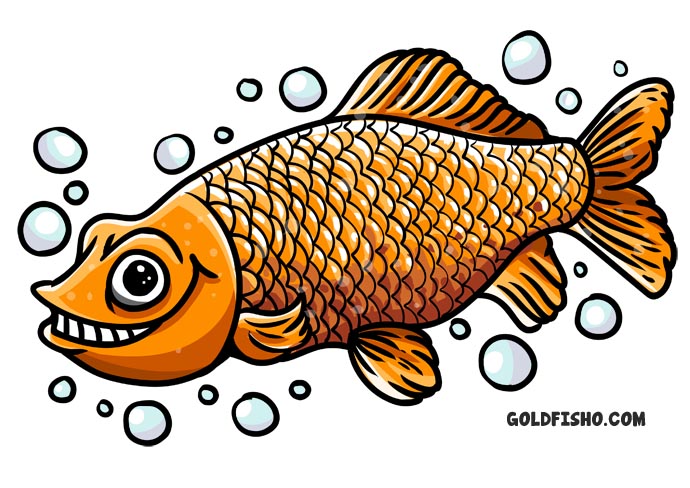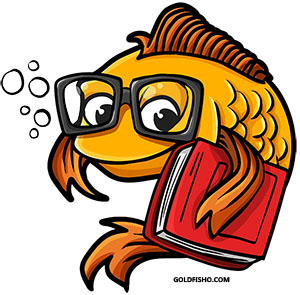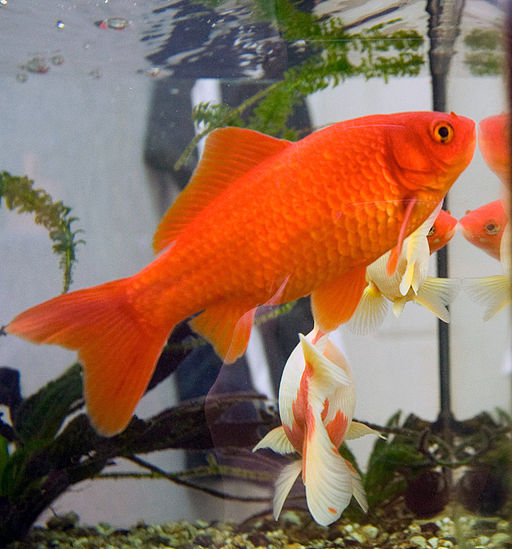Goldfish are sold in a variety of colors, shapes, sizes, breeds, patterns, and tail designs. Each of them is a little different and can make fantastic pets.

However, these varieties of golden beauties would never have developed if it were not for the original breed, The Common Goldfish.
Without them, having fish as pets may have never even been an option.
History: Where did The Common Goldfish originate?
The Common Goldfish was the first “mutation” to develop from the Ancient Chinese breeding Carp. During the 200’s to mid-400, the Chinese began breeding Carp.
Along this journey, they noticed some of the fish were developing a beautiful yellow-orange coloration (instead of the standard silvery coloration that Carp have).
These color “mutations” were much more attractive to the Chinese than the silver coloration, and so, they decided to breed strictly the fish that were developing yellow-orange scales.
Later, the Japanese are thought to have continued this process thus leading to the many varieties of goldfish we have today.
The Common Goldfish is no longer only found in that golden orange hue. Today, they are various colorations including white, black, red, yellow, orange, and brown.
Physical Characteristics of The Common Goldfish
How can I identify them in an aquarium?
The Common Goldfish is the most well-known breed of goldfish hence the name “The Common Goldfish”. They were once easy to identify in an aquarium simply because they were one of the only varieties of goldfish to choose from.
Today, each goldfish breed slightly resembles another, and it can be a little confusing and difficult to identify each of them correctly.
The original goldfish, the Common Goldfish, has a long, slender body shape that is usually quite flat. Fish with this body type have an enhanced swimming ability and will use this agility to their advantage during feeding time.
Their heads are slightly wider and slightly shorter than that of the Comet Goldfish (which is their closest goldfish relative).
Their head shape and their body shape make them quite desirable because they are one of the only current goldfish breeds to be proportionate all the way around.
Even in regards to their caudal fin (tail fin). Their tail fins are not too long or too short for their body size or shape.
The Common Goldfish’s tail fin has a slight fork in it (unlike The Comet which has a deeper forked caudal fin).
Their physical characteristics are the perfect combination for a fast and able swimmer. They require enough surface area in their aquariums to swim as much as they please as well as space to grow.
Goldfish can continue to grow until they inevitably die. With this in mind, the Common Goldfish would be happiest in a large tank so he can reach his full potential.
Finally, as previously mentioned the Common Goldfish can be found in a variety of solid colorations.
The most popular coloration for the breed being a bright orange with a metallic flare. Other solid colorations for the breed include; brown, white, red, black, and yellow.
Care: Is The Common Goldfish difficult to care for?
In regards to goldfish as a species, they can be relatively easy to take care of. The Common Goldfish is one of the toughest goldfish breeds. This is one reason why they are recommended for a child’s aquarium or simply as a “beginner fish.”
Being nominated as a “beginner fish” does not mean that their owners should not respect them as living beings nor does it imply that they are replaceable and expendable.
It just means that if someone has never owned a fish as a pet before and is interested in doing so that he or she should start off with a breed that is not fragile or would require special care.
For example, there are certain goldfish breeds such as the Bubble Eyed Fancy Goldfish, which is so delicate that their aquariums need to be “fish proof” meaning no sharp objects in the tank.
This includes their filtration system. Filters have pointy edges that can easily damage their fluid-filled sacs; therefore, the owners must take precaution and cover the pointy edges and the intake valves to avoid the sacs from being sucked into the mechanism.
In comparison to delicate goldfish breeds such as the Bubble Eyed Fancy Goldfish, yes, the Common Goldfish is easy to care for.
Nutrition and Feeding: What does The Common Goldfish eat?
While many of you may think that this section is not warranted, you may be surprised to the answer.
Goldfish that are dumped in rivers, lakes, streams, and ponds do not have the luxury of going to the pet store and purchasing fish flakes.
Shocking, I know.
In fact, goldfish either in the wild or captivity are happiest and healthiest when they are eating a variety of natural foods.
They are omnivores, after all, and enjoy various foods (they even will eat their vegetables!).
So, what should you be feeding your Common Goldfish?
How much should you feed them as well as how often? Well, let’s find out!
Fish Flakes: This type of fish food has been lining pet store shelves for many years. These flakes are a decent option to choose for your goldfish and of course, they will gobble them right up!
Fish flakes are not lacking any nutritional value, either. In fact, they contain ingredients such as Vitamin C, oatmeal, fish oil, and sorbitol.
What is sorbitol?
Sorbitol is an ingredient naturally produced in fruit giving them their sweet flavor.
Sorbitol is then added to certain processed foods (such as fish flakes) to make them more attractive to the taste buds.
Your goldfish should only be fed fish flakes 2 to 3 times per day. The rule of thumb for quantity is a small pinch, or however much your fish can consume within a 3-minute time span.
If you notice after 3 minutes that fish flakes are going uneaten, then you are feeding too much and should provide a smaller pinch next time.
Fish Pellets: This is another common fish food for most goldfish owners. Pellets follow many of the same rules as fish flakes do in regards to how much as how often.
Provide a small pinch of pellets (usually that means 3 to 5 pellets) a couple of times per day (usually 2 to 3 times).
Pellets are full of ingredients known as “fillers” that are used to help keep the fish fuller longer. Goldfish are natural munchers and can experience the urge to munch at any point in the day. These fillers are a way of cutting down on this munching.
Why is munching so bad for goldfish? Goldfish can become overweight if they are not fed a proper diet. An obese fish is a sick (or dead) fish.
If you want to own goldfish, take care of them the right way. Fish pellets do not just contain fillers. They also contain antioxidants known as Astaxanthin as well as Spirulina.
What is Spirulina?
Spirulina is a type of aquatic algae that is an excellent source of vitamins and minerals.
Small Fish: This is not usually a good option for aquarium goldfish. They may not be accustomed to consuming them which could lead to unwanted results.
One potential outcome is that the goldfish allow the small fish (which would have been a meal) to share their tank.
That means that you now have more inhabitants living in the tank than you planned for.
More residents mean less oxygen in the water, more waste in the water, and ultimately more tank cleanings and water changes you would have to do.
On the other hand, your goldfish could enjoy eating these small fish meals. The positive of this would be that they provide your goldfish with loads of protein, vitamins, minerals, and are likely to keep them fuller longer.
However, these small fish can be expensive, and a strict diet of small fish is not recommended.
Vegetables: Goldfish are omnivores and will eat (or try to eat) just about anything you give them. Vegetables are no different.
In fact, goldfish enjoy vegetables as part of their daily diet. Specifically, they enjoy mashed peas, lettuce, and broccoli.
Goldfish should not be fed vegetables for every meal throughout the day. A few times a week would suffice.
Also, vegetables are one food option that should be slowly hand fed to the fish. This will eliminate the amount of uneaten food that accumulates at the bottom of the tank.
Algae: Algae is not usually a food option that you need to purchase because it will grow naturally inside the tank on its own.
Your goldfish will probably use the algae when they feel the need to munch on something, and it is not yet dinner time.
However, it is not enough for them to consider a meal. You will still need to provide 2 to 3 meals per day to help your goldfish have a well-rounded diet.
Plants and plant roots: When goldfish are dumped in lakes, ponds, streams, and rivers they must forage for their meals rather than rely on their owners to provide it. Goldfish are not only great at foraging for food and munching throughout the day, but they are also prone to digging.
Yes, digging.
Goldfish have been known to dig up live aquatic plants and munch on the leaves and the roots. They will even do this in captivity.
Leaves and roots provide goldfish with fiber and other nutrients that aid their digestive systems. If you are interested in providing live aquatic plants for your goldfish, consider Egeria, Rotala, or Camboba. They are sure to get your goldfish through his munchies.
You can also choose an attractive floating plant called Duckweed. Goldfish enjoy this plant, although it is a better choice for goldfish ponds rather than goldfish aquariums.
Insects: Goldfish that live in outdoor ponds or water gardens are much more likely to be seen eating bugs because many fish owners do not have the desire to hand feed their goldfish a bunch of creepy crawlies.
However, if you can stomach it, then you should consider providing insects to your goldfish. They are very fond of water fleas, mosquito larvae, and flies. You can also consider choosing worms such as earthworms or bloodworms
.

No matter what kind of food choice you want for your goldfish be sure only to feed them store bought rather than food found outside. Insects, worms, plants, etc. that come directly from outside could be contaminated by pesticides or other harmful chemicals that would undoubtedly kill your goldfish.
Habitat Requirements:
What kind of aquarium should I get for my Common Goldfish?
Common Goldfish are fast and agile swimmers. They will require the largest aquarium that you can afford to buy as well as how much space you have for it.
The larger the tank, the more surface area your goldfish will have to swim, grow and breathe in good oxygen.
The particular aquarium size that you should purchase will greatly depend on what you want to have, what you can afford to have, and what you have room to have.
Goldfish require at least 20-gallons of water per fish. If you do not have a very flexible wallet, then you should plan on one to two goldfish (equaling a 20-gallon to 40-gallon aquarium).
These tanks are not all that expensive and are sometimes sold as kits to provide you with the necessary “startup” materials.
While aquariums come in various shapes and sizes, it is recommended to stick with a large rectangle aquarium with a stand for goldfish tanks. Rectangle aquariums provide adequate surface area for swimming, growing and proper oxygen levels.
Personality and Temperament:
How will my Common Goldfish act around other fish and my family?
Common Goldfish are a non-aggressive goldfish breed.
In fact, they are actively peaceful with others. They are not afraid of their owners and will often anticipate their arrival home from work.
Goldfish are more intelligent than they look! They can recognize their tankmates and their owners and be able to distinguish them from other fish (or other people).
When a Common Goldfish is being bullied or threatened by another fish or living being, then the fish may become slightly aggressive to protect himself.
Also, Common Goldfish should never share a tank with slower swimming fish.
“Handicapped” goldfish should be tankmates with other handicapped goldfish and agile swimmers should be tankmates with other agile swimmers.
For example, The Common Goldfish would be happiest if he were tankmates with The Shubunkin Goldfish (any of the three varieties) or The Comet Goldfish.
Health Problems: What should I look out for?
Goldfish ICH: This common fish disease is also known as White Spot Disease because that is the most tell-tale symptom of ICH. Your goldfish will appear to have been rolled in salt, sugar or flour overnight. These white spots are actually parasites feeding off of your goldfish’s tissues.

When they are done feeding they release, reproduce and start all over again.
Fin rot or Tail Rot: This disease appears as though your goldfish’s fins are disintegrating right before your eyes. If you notice your goldfish seems to be “rotting away” then take action immediately with the proper treatments. Another common goldfish disease to be aware of includes:
- Velvet Disease (Gold Dust Disease)
- Anchor Worm
- Mouth Rot
- Fish Lice
The best way to recognize if your fish is sick is to be observant and spend time with them every day. You should also try to prevent any diseases or illnesses from occurring by keeping up on water changes, and tank cleanings. Make sure to provide a good filtration system to help eliminate harmful bacteria between bi-weekly cleanings.
It is also important that you do not overpopulate your aquariums as this will quickly contribute to the water’s pollution.
Common Goldfish Questions and Answers

What is a Common Goldfish?
Type: hardy
Colors: orange, yellow, white, red, black, chocolate
Type of Swimmer: fast
Temperament: peaceful
Single or Twin-tail: single
Level of Care: great for beginners
What does a Common Goldfish cost?
$3 – $7 each
What are compatible tank mates for Common goldfish?
Comets and Shubunkins
Note: Slow swimming goldfish should not be placed with fast swimming goldfish. Fast swimmers are aggressive eaters at feedings.
Characteristics and Traits of Common Goldfish
How large does a Common Goldfish get?
4”
What is the lifespan of Common Goldfish?
10-15 years
Diet of Common Goldfish
What does a Common Goldfish eat?
Pellets
Live food (bloodworms, shrimp)
Fruits & vegetables
Flake food
Tank Requirements for Common Goldfish
What size tank does a Common Goldfish need?
Minimum: 20-30 gallons
Fish-to-tank Ratio is 1” of fish per 1 gallon of water
What should the water temperature be for a Common Goldfish; and do I need to have a heater for the tank?
65 – 72 degrees (F)
A heater is required to maintain water temperature.
Do I need to have an air stone (air pump) in my Common Goldfish tank?
Yes
Does a Common Goldfish tank require a filtration system?
Yes, all goldfish should have a filtration system in their tank.
Have you had Common Goldfish? Do you have photos or videos you’d like to share. Comment Below


